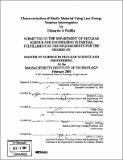Characterization of fissile material using low energy neutron interrogation
Author(s)
Padilla, Eduardo A
DownloadFull printable version (4.262Mb)
Other Contributors
Massachusetts Institute of Technology. Dept. of Nuclear Science and Engineering.
Advisor
Richard C. Lanza.
Terms of use
Metadata
Show full item recordAbstract
The glaring need to develop methods for detecting and interdicting illicit nuclear trafficking has resulted in the exploration of various methods for active neutron interrogation, specifically for the presence of special nuclear material (SNM) in cargo containers. The proposed system aims to defeat the ability of terrorists to import SNM into the United States via maritime shipping, thus greatly reducing the possibility of a successful nuclear terrorist attack. The proposed system uses 60-100 keV neutrons, produced by the 7Li(p,n)7Be reaction in a linear accelerator and kinematically beamed into various targets. In the event that fissile material is present, highly energetic neutrons will be emitted from the fissioning of a nucleus and some of these neutrons will eventually radiate from the container. Inevitably, high energy photons will also radiate from the target due to the interactions of neutrons and host materials. Utilizing a neutron detection system that is able to discriminate low energy neutrons, high energy gamma rays and the high energy neutrons from fission enables the detection of fissile material in various containers. An increase in discriminated high energy neutron events during active neutron interrogation selectively indicates the presence of SNM, since neutron energies on the order of 1 MeV are required for the SNM-equivalent fissioning potential when incident upon U238 and other high-Z nuclei. Furthermore, neutrons with less than approximately 100 keV do not undergo nuclear processes such as (n,2n) and (n,n'), but rather lose their energy through kinematic collisions. (cont.)Results obtained validate this proof-of-concept, in that observed high energy neutron events increase significantly in the presence of gram-quantities of SNM. Further, attempts made to shield the SNM from active interrogation do not defeat the proposed system's ability to identify the presence of SNM. With a fully-functional proof-of-concept, further work towards developing a complete and deployable prototype active neutron interrogation system will serve to augment the ability of the United States to detect, deter and interdict illicit nuclear trafficking.
Description
Thesis (S.M.)--Massachusetts Institute of Technology, Dept. of Nuclear Science and Engineering, 2007. Includes bibliographical references (p. 76).
Date issued
2007Department
Massachusetts Institute of Technology. Department of Nuclear Science and EngineeringPublisher
Massachusetts Institute of Technology
Keywords
Nuclear Science and Engineering.